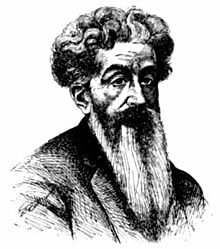Ramón Emeterio Betances
Ramón Emeterio Betances y Alacán (born April 8, 1827 in Cabo Rojo , Puerto Rico , † September 18, 1898 in Neuilly-sur-Seine , France ) was the leader of the Grito de Lares and is considered the father of the Puerto Rican independence movement.
Life
The son of wealthy landowners, Ramón Emeterio Betances received his education at private elite schools. His mother died when he was a young man and his father sent him to France . In 1846 he obtained his Baccalaureus Artium and then studied medicine in Paris . In 1853 he completed his studies at the Sorbonne as a doctor of medicine and surgery .
On his return to Puerto Rico, he first built a hospital in Mayagüez . Its use, he saved many Puerto Ricans before the cholera - epidemic in 1856. At that time, there was the first confrontations with Spanish rulers since Betances the native Spaniards in the military treated the worst. He donated a lot for the poor and was therefore known as the "Father of the Poor".
independence
Betances believed in the abolition of slavery and founded a secret organization called the Secret Abolitionist Society . The group wanted to free child slaves through the sacrament of baptism . Also known as the “aguas de libertad” (water of freedom), the event took place in Mayagüez Cathedral . After the child was baptized, Betances gave the parents money to buy the child out.
The Spanish government, which ruled Puerto Rico, banned Betances into exile . This fled to the Dominican Republic and went from there to New York City where he and Segundo Ruiz Belvis , the Revolutionary Committee of Puerto Rico (The Revolution Committee of Puerto Rico) founded. Betances and Ruiz returned to the Dominican Republic, where they formed an armed expedition to invade the island. They also established revolutionary cells in Puerto Rico, which u. a. were led by Manuel Rojas and Mathias Brugman . Betances commissioned Mariana Bracetti to sew a flag for the revolution in the colors of the Dominican Republic. All of these factors ultimately led to the failed uprising that went down in history as the Grito de Lares .
Betances then returned to Paris, where he continued his struggle for the independence of Puerto Rico. The abolition of slavery on March 22, 1873 was a great success for him. The French government honored him with the Legion of Honor for his literary works .
Betances died in France in 1898. The nationalist party, the Puerto Rican Nationalist Party, led by José Coll y Cuchi, persuaded the government legislature to approve a transfer of Betances' body to Puerto Rico. On August 5, 1920, the patriot's body arrived in San Juan , from where it was taken to Cabo Rojo for burial .
A bust by the Italian sculptor Diego Montano can be seen together with the revolutionary flag of the Grito de Lares and the flag of Puerto Rico in the market square of Cabo Rojo, which is named after Betances.
Works
- Toussaint L'ouverture, los dos indios (1852)
- Un premio de Luis XIV (1853)
- Las cortesanas in Paris (1853)
- La Vierge de Borinquén (1859)
- La botijuela (1863)
- Washington Haitiano (essay on Alexandre Pétion , 1871)
- Los viajes de Scaldado (1890)
Web links
| personal data | |
|---|---|
| SURNAME | Betances, Ramón Emeterio |
| ALTERNATIVE NAMES | Betances y Alacán, Ramón Emeterio |
| BRIEF DESCRIPTION | Father of the Puerto Rican independence movement |
| DATE OF BIRTH | April 8, 1827 |
| PLACE OF BIRTH | Cabo Rojo , Puerto Rico , Spanish Empire |
| DATE OF DEATH | September 18, 1898 |
| Place of death | Neuilly-sur-Seine , Seine department , France |
